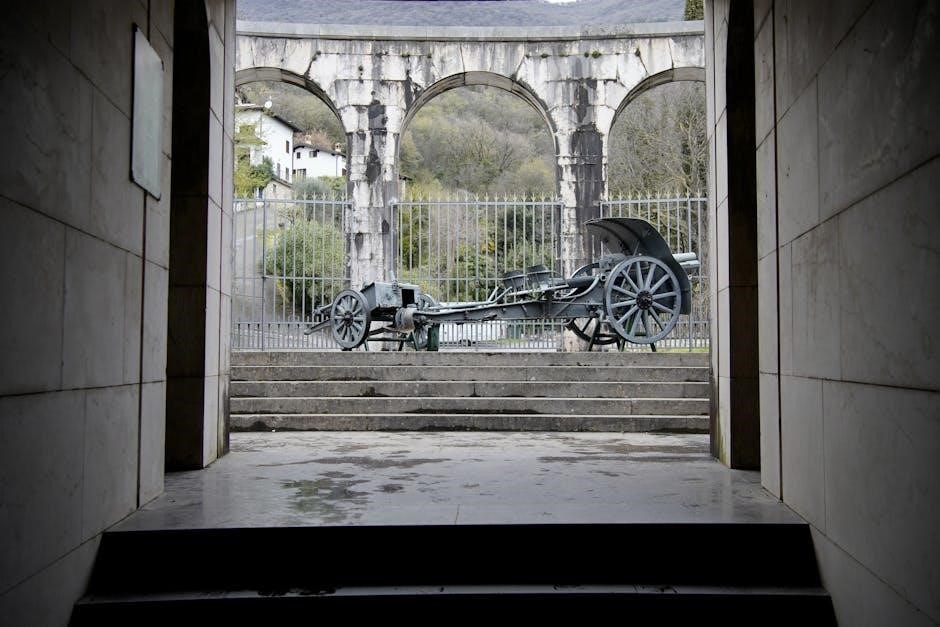El Arte de la Guerra‚ an ancient military strategy treatise by Sun Tzu‚ remains timeless. Its principles‚ accessible in PDF‚ offer insights into warfare and leadership‚ influencing Napoleon and modern business strategies.
1.1 Overview of the Book
El Arte de la Guerra is an ancient military strategy treatise by Sun Tzu‚ written around 500 BC. It explores tactics and principles for winning conflicts through deception‚ knowledge of the enemy‚ and economy of forces. The book‚ now widely available in PDF‚ remains a foundational text for military and leadership strategies‚ influencing figures like Napoleon and Mao Tse Tung. Its timeless wisdom extends beyond warfare‚ offering insights for business and personal growth‚ cementing its relevance in modern times.
1.2 Historical Significance
El Arte de la Guerra‚ written by Sun Tzu around 500 BC‚ is the oldest known military strategy treatise. Its principles have shaped warfare and leadership globally‚ influencing iconic leaders like Napoleon and Mao Tse Tung. The book’s ideas spread across Asia‚ deeply impacting Japanese military thought. Its timeless relevance has made it a cornerstone of strategic thinking‚ transcending its ancient origins to remain a vital resource for understanding conflict and competition‚ ensuring its enduring legacy as a foundational text in military history.

Historical Context of “El Arte de la Guerra”
El Arte de la Guerra‚ written by Sun Tzu around 500 BC‚ emerged during the Warring States Period‚ a time of intense conflict in ancient China. The PDF version preserves this timeless text‚ ensuring its accessibility and relevance in modern times‚ bridging ancient wisdom with contemporary readers.
2.1 The Life and Times of Sun Tzu
Sun Tzu‚ a revered Chinese military strategist‚ lived during the 6th century BC‚ in the Spring and Autumn period. His iconic work‚ El Arte de la Guerra‚ remains a cornerstone of military and leadership philosophy. Though details of his personal life are scarce‚ his teachings‚ now widely available in PDF‚ emphasize strategy‚ deception‚ and understanding the enemy. Sun Tzu’s legacy endures‚ influencing modern thought and applications beyond warfare‚ ensuring his ideas remain relevant across centuries.
2.2 The Warring States Period
The Warring States Period (475–221 BC) was a time of intense conflict in China‚ shaping the backdrop for Sun Tzu’s teachings. This era of constant warfare and political upheaval inspired his pragmatic approach to strategy. The period’s instability highlighted the need for clever tactics and adaptability‚ principles central to El Arte de la Guerra. Sun Tzu’s work‚ now widely available in PDF‚ reflects the lessons learned during this tumultuous time‚ offering timeless wisdom for both military and non-military contexts.

Key Themes and Concepts
El Arte de la Guerra explores strategy‚ deception‚ and understanding the enemy. Its teachings emphasize economy of forces and achieving victory without conflict‚ influencing diverse fields.
3.1 The Importance of Strategy
In El Arte de la Guerra‚ strategy is the cornerstone of successful warfare. Sun Tzu emphasizes the need for meticulous planning‚ adaptability‚ and intelligent use of resources. By understanding the battlefield‚ leveraging deception‚ and aligning actions with the enemy’s weaknesses‚ victory becomes achievable without direct confrontation. This philosophy transcends military contexts‚ offering timeless lessons for business‚ leadership‚ and personal growth‚ as highlighted in the PDF version of the text.
3.2 The Role of Deception
Deception is a central tenet in El Arte de la Guerra. Sun Tzu advocates for misleading the enemy to gain an advantage‚ emphasizing that “the art of war is based on deception.” By feigning weakness or strength‚ a commander can disrupt the enemy’s plans and create opportunities for victory. This principle extends beyond warfare‚ offering strategic value in business and leadership‚ as highlighted in the PDF version of the text‚ making it a timeless and versatile guide for outwitting opponents.
3.3 Knowledge of the Enemy
Knowledge of the enemy is crucial in El Arte de la Guerra. Sun Tzu stresses the importance of understanding the enemy’s strengths‚ weaknesses‚ and disposition. This insight allows a commander to exploit vulnerabilities and gain a strategic advantage. The PDF version of the text emphasizes that knowing the enemy enables victory without direct confrontation‚ aligning with the principle of achieving success through wisdom rather than force. This concept remains relevant in modern applications‚ from military tactics to competitive business strategies.
3.4 Economy of Forces
Economy of forces is a central theme in El Arte de la Guerra. Sun Tzu emphasizes minimizing waste and maximizing efficiency in warfare. By focusing resources on critical objectives and leveraging deception‚ a commander can achieve victory without prolonged conflict. This principle underscores the importance of strategic allocation and the avoidance of unnecessary battles‚ ensuring that efforts are concentrated where they matter most. The PDF version highlights how this concept remains applicable in modern contexts‚ from business to leadership‚ emphasizing the value of efficiency and precision.

Structure of the Book
El Arte de la Guerra is structured into 13 concise chapters‚ each focusing on distinct strategic principles. The PDF format preserves this timeless organization‚ making it easy to navigate and study Sun Tzu’s teachings on warfare and leadership‚ ensuring clarity and accessibility for modern readers.
4.1 The 13 Chapters
The PDF version of El Arte de la Guerra retains the original structure‚ dividing the text into 13 chapters. Each chapter focuses on a distinct aspect of warfare‚ such as planning‚ tactics‚ and espionage. The first chapter emphasizes the importance of planning and understanding the enemy‚ while later chapters delve into terrain‚ alliances‚ and the use of spies. This clear organization ensures that readers can easily navigate Sun Tzu’s timeless principles‚ making the PDF a valuable resource for both historical and modern applications of his strategies.
4.2 Key Principles in Each Chapter
Each chapter in the PDF of El Arte de la Guerra introduces core principles of warfare. Chapter 1 emphasizes planning and knowing the enemy‚ while Chapter 2 focuses on deception and adaptability. Later chapters explore terrain‚ alliances‚ and the strategic use of spies. The final chapters discuss leadership and the ultimate goal of winning without direct conflict. These principles‚ outlined in the PDF‚ provide a comprehensive guide to strategic thinking‚ applicable beyond military contexts to business and leadership scenarios.
The Author: Sun Tzu
Sun Tzu‚ a renowned Chinese military strategist‚ authored El Arte de la Guerra‚ leaving a legacy of timeless principles influencing military and leadership strategies globally.
5.1 Sun Tzu’s Background
Sun Tzu‚ born around 544 BC‚ was a Chinese military strategist and philosopher. Known as the author of El Arte de la Guerra‚ his work remains influential. His teachings emphasize strategy‚ deception‚ and understanding the enemy. Sun Tzu’s principles have transcended warfare‚ impacting business and leadership. His legacy endures‚ with El Arte de la Guerra available in PDF‚ ensuring accessibility for modern readers worldwide.
5.2 Sun Tzu’s Legacy
Sun Tzu’s legacy endures as a cornerstone of strategic thought. His principles in El Arte de la Guerra‚ now widely available in PDF‚ have shaped military tactics‚ business strategies‚ and leadership worldwide. His ideas on deception‚ economy of forces‚ and knowledge of the enemy remain timeless. Sun Tzu’s work has inspired figures like Napoleon and Mao Tse Tung‚ cementing his influence across centuries and cultures.

The Book’s Influence
El Arte de la Guerra’s influence extends beyond warfare‚ shaping military and corporate strategies globally; Its timeless principles‚ accessible via PDF‚ inspire leaders and strategists worldwide.
6.1 Impact on Military Thought
El Arte de la Guerra revolutionized military strategy‚ emphasizing deception‚ adaptability‚ and knowledge of the enemy. Its principles‚ now accessible in PDF‚ have shaped warfare tactics globally. Sun Tzu’s ideas influenced legendary leaders like Napoleon and Mao Zedong‚ transforming how conflicts are approached. The book’s emphasis on psychological warfare and strategic planning remains foundational in modern military doctrine‚ ensuring its relevance across centuries. Its timeless wisdom continues to inspire generals and strategists worldwide‚ solidifying its legacy as a cornerstone of military thought.
6.2 Beyond Warfare: Applications in Business and Leadership
El Arte de la Guerra transcends military contexts‚ offering strategies applicable to business and leadership. Its principles‚ like deception‚ adaptability‚ and knowing the competition‚ are used in market positioning and negotiations. Leaders leverage these ideas for decision-making and team management. The economy of forces concept aids in resource optimization‚ while adaptability ensures resilience in competitive environments. These applications have solidified the book as a key text in modern business and leadership‚ extending its influence beyond traditional warfare into corporate strategy and executive development.

The Psychology of Warfare
El Arte de la Guerra delves into the mental dimensions of conflict‚ emphasizing understanding the enemy’s mindset and maintaining morale to ensure strategic superiority and effective troop management.
7.1 Understanding the Mind of the Commander
El Arte de la Guerra emphasizes the psychological aspects of warfare‚ particularly the commander’s mindset. Sun Tzu highlights the importance of mental clarity‚ strategic vision‚ and adaptability. A commander must understand their own strengths and weaknesses‚ as well as those of the enemy‚ to make informed decisions. The ability to anticipate and respond to the opponent’s mindset is crucial for achieving victory. This psychological insight remains a cornerstone of modern leadership and strategy‚ as outlined in the PDF version of the text.
7.2 Morale and Troop Management
El Arte de la Guerra underscores the importance of morale in achieving victory. Sun Tzu advocates for fostering unity and discipline among troops‚ ensuring their spirits remain high. A commander must lead by example‚ inspiring loyalty and confidence. Low morale‚ conversely‚ can lead to defeat. The PDF version highlights strategies to maintain troop cohesion‚ emphasizing psychological strength as a critical factor in warfare. This timeless advice remains relevant for modern leadership and conflict resolution‚ offering insights into effective team management.

Strategic Concepts
El Arte de la Guerra introduces essential strategic concepts like the five fundamental factors and economy of forces. These ideas‚ detailed in the PDF‚ emphasize adaptability and deception‚ providing timeless guidance for warfare and leadership‚ ensuring effective command and calculated strategies to achieve victory.
8.1 The Five Fundamental Factors
The five fundamental factors outlined in El Arte de la Guerra are critical for strategic success. These include the Way‚ Heaven‚ Earth‚ the Commander‚ and Method. The Way ensures alignment with societal values‚ Heaven represents the influence of climate and timing‚ Earth pertains to terrain and geography‚ the Commander embodies leadership and wisdom‚ and Method involves organization and discipline. These factors‚ detailed in the PDF‚ provide a holistic approach to understanding and mastering strategic planning‚ ensuring adaptability and efficiency in any conflict or competition.
8.2 The Six Calamities
The Six Calamities in El Arte de la Guerra highlight pitfalls to avoid in warfare. These include recklessness‚ cowardice‚ a hasty temper‚ strictness‚ overprotectiveness‚ and excessive ambition. The PDF elaborates on each‚ emphasizing how these traits can lead to defeat. Sun Tzu stresses the importance of self-awareness and emotional control for effective leadership. By understanding these calamities‚ leaders can mitigate risks and foster a disciplined‚ resilient force capable of overcoming challenges and achieving victory. This wisdom remains applicable in both military and modern contexts.
8.3 The Nine Variables
The Nine Variables in El Arte de la Guerra outline critical factors influencing warfare. These include the sovereign’s will‚ the generals’ strength‚ the adversary’s vulnerabilities‚ and environmental conditions. The PDF version details how these variables interact‚ emphasizing adaptability and situational awareness. Sun Tzu advises leaders to align their strategies with these variables to ensure victory. This framework remains a cornerstone of strategic planning‚ applicable not only in warfare but also in business and leadership roles‚ as highlighted in the text.
The Art of War in Modern Context
El Arte de la Guerra in PDF remains relevant today. Its strategies are applied in business‚ leadership‚ and technology‚ proving Sun Tzu’s timeless wisdom in modern scenarios.
9.1 Modern Applications of Ancient Strategies
The principles of El Arte de la Guerra are widely applied in modern contexts‚ from business strategies to digital marketing. Available in PDF‚ Sun Tzu’s timeless wisdom on deception‚ adaptability‚ and knowing the enemy is now used by executives and leaders globally. Its teachings on economy of forces and strategic planning resonate in corporate boardrooms‚ while its psychological insights are leveraged in sports and politics. The PDF format ensures accessibility‚ making these ancient strategies relevant in the digital age‚ bridging centuries of wisdom with contemporary challenges.
9.2 The Role of Technology
Technology has revolutionized warfare‚ aligning with Sun Tzu’s principles in El Arte de la Guerra. The PDF version highlights how modern tools like drones‚ AI‚ and cybersecurity apply ancient strategies. Surveillance and data analysis mirror the importance of knowing the enemy. Digital platforms enable rapid decision-making‚ echoing Sun Tzu’s emphasis on adaptability. Technology also democratizes access to these timeless strategies‚ ensuring their relevance in contemporary conflicts and beyond‚ as outlined in the PDF format of this enduring treaty.

The PDF Version of “El Arte de la Guerra”
The PDF version of El Arte de la Guerra offers a modern‚ accessible format of Sun Tzu’s timeless strategies. It preserves the book’s essence while ensuring portability and easy sharing‚ making ancient wisdom readily available for contemporary readers worldwide.
10.1 Availability and Accessibility
The PDF version of El Arte de la Guerra is widely available online‚ making Sun Tzu’s timeless strategies accessible to a global audience. It can be downloaded from various platforms‚ including online libraries‚ eBookstores‚ and official websites. The digital format ensures portability‚ allowing readers to access the text on multiple devices. Additionally‚ its availability in multiple languages‚ including Spanish and English‚ has broadened its reach‚ ensuring that the wisdom of Sun Tzu remains accessible to readers worldwide.
10.2 Benefits of the PDF Format
The PDF format of El Arte de la Guerra offers numerous advantages. It preserves the original text’s integrity‚ ensuring clarity and readability. The file is easily shareable and accessible across various devices‚ making it convenient for readers to study Sun Tzu’s strategies anywhere. PDFs also allow for highlighting and annotation‚ enabling deeper engagement with the content. Moreover‚ the format maintains the book’s structure‚ including its historical and philosophical depth‚ providing an authentic reading experience.
10.3 Challenges of the PDF Format
While the PDF format of El Arte de la Guerra offers convenience‚ it also presents challenges. The file may require specific software for viewing‚ limiting accessibility for some users. Additionally‚ PDFs can be difficult to edit or update‚ potentially leading to outdated content. The format may also lack interactive features‚ reducing engagement for modern readers accustomed to dynamic content. Furthermore‚ large file sizes could pose storage issues‚ especially for users with limited device capacity. These limitations highlight the need for alternative formats to enhance accessibility and usability.

Cultural Impact of “El Arte de la Guerra”
El Arte de la Guerra has profoundly influenced Asian culture and beyond‚ inspiring art‚ leadership‚ and strategic thinking. Its principles resonate globally‚ transcending warfare.
11.1 Influence on Asian Culture
El Arte de la Guerra has deeply influenced Asian culture‚ shaping military tactics‚ philosophy‚ and leadership. Its spread to Japan inspired samurai strategies and cultural practices. Beyond warfare‚ its principles have been applied to art‚ business‚ and everyday life‚ emphasizing harmony and strategic thinking. The book’s concepts‚ like understanding physical spaces through circulation and flow‚ have resonated widely‚ making it a cornerstone of Asian intellectual heritage.
11.2 Reception in the Western World
El Arte de la Guerra gained prominence in the West through translations and adaptations. Its strategic principles‚ like deception and economy of forces‚ inspired military leaders such as Napoleon and modern business strategists. The book’s timeless wisdom transcended warfare‚ influencing leadership and competitive tactics. Its PDF availability has further globalized its reach‚ making it a cornerstone of both military and corporate strategy‚ bridging cultural and temporal divides with its universal insights.

The Legacy of “El Arte de la Guerra”
El Arte de la Guerra endures as a timeless guide‚ influencing military and leadership strategies globally. Its PDF version ensures accessibility‚ preserving Sun Tzu’s wisdom for future generations.
12.1 Timeless Relevance
El Arte de la Guerra remains a cornerstone of strategic thought‚ transcending time and cultural boundaries. Its principles‚ now widely accessible in PDF‚ continue to inspire leaders‚ entrepreneurs‚ and military strategists worldwide. The timeless wisdom of Sun Tzu‚ such as the importance of deception and understanding the enemy‚ resonates across centuries. Its universal appeal lies in its adaptability‚ making it a invaluable resource for modern applications‚ from business tactics to personal growth‚ ensuring its relevance in an ever-changing world.
12.2 Continued Study and Adaptation
El Arte de la Guerra continues to be studied and adapted across various fields. Its timeless principles‚ now accessible in PDF‚ are applied in modern contexts such as business‚ leadership‚ and sports. Scholars and practitioners worldwide analyze Sun Tzu’s strategies‚ finding relevance in contemporary challenges. The book’s versatility ensures its enduring popularity‚ as its teachings evolve to meet the demands of a changing world‚ making it a cornerstone of strategic thinking for future generations.
El Arte de la Guerra remains a timeless guide to strategy and leadership. Its availability in PDF ensures its teachings are accessible‚ making it a must-read for understanding strategic thinking across various fields.
13.1 Summary of Key Points
El Arte de la Guerra by Sun Tzu is a timeless guide to strategy and warfare. Its principles‚ such as deception‚ knowing the enemy‚ and economy of forces‚ remain universally applicable. Available in PDF‚ the text continues to inspire leaders in military‚ business‚ and beyond. It emphasizes the importance of planning‚ adaptability‚ and psychological warfare‚ offering insights that transcend its ancient origins. The book’s enduring relevance lies in its ability to apply to modern challenges‚ making it a cornerstone of strategic thought.
13.2 Final Thoughts on the Book’s Significance
El Arte de la Guerra by Sun Tzu is a profound work whose relevance transcends time and context. Its PDF availability ensures global access to timeless strategies‚ influencing military‚ business‚ and leadership. The book’s core lies in its universal principles‚ emphasizing adaptability‚ deception‚ and understanding the enemy. Its impact on historical figures like Napoleon and Mao Tse Tung underscores its enduring value. As a guide to strategic thinking‚ it remains essential for modern leaders seeking wisdom in conflict and competition.
